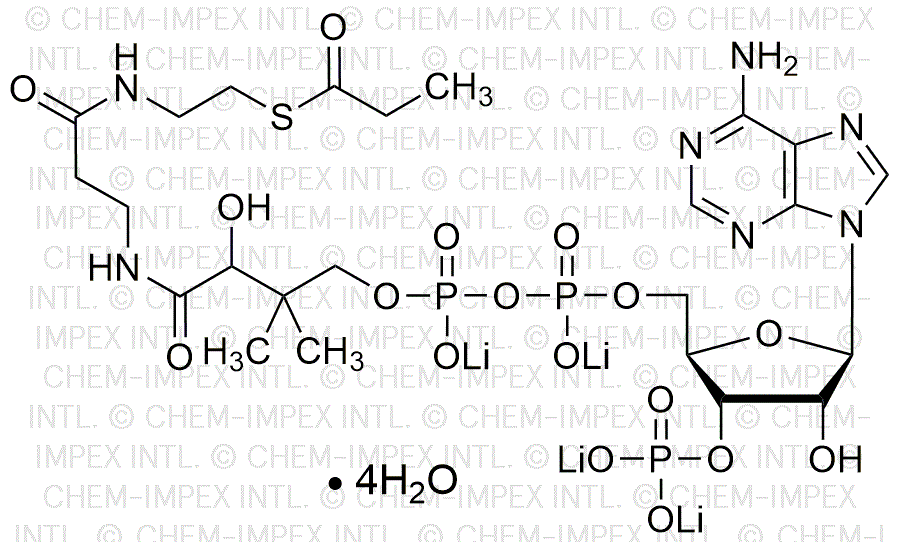Propionyl coenzyme A lithium salt is widely utilized in research focused on:
- Metabolic Studies: This compound plays a crucial role in studying metabolic pathways, particularly in energy production and fatty acid metabolism, helping researchers understand cellular processes.
- Drug Development: It serves as a valuable intermediate in synthesizing pharmaceuticals, particularly in developing medications targeting metabolic disorders, enhancing drug efficacy.
- Biochemical Assays: Used in various assays to measure enzyme activity related to coenzyme A, it aids in understanding enzyme kinetics and regulation in biochemical research.
- Genetic Research: The compound is instrumental in genetic studies, particularly those exploring gene expression related to metabolic enzymes, facilitating advancements in gene therapy.
- Food Industry Applications: It can be applied in food science to study flavor compounds and their interactions, contributing to the development of enhanced food products.
Informations générales
Propriétés
Sécurité et réglementation
Applications
Propionyl coenzyme A lithium salt is widely utilized in research focused on:
- Metabolic Studies: This compound plays a crucial role in studying metabolic pathways, particularly in energy production and fatty acid metabolism, helping researchers understand cellular processes.
- Drug Development: It serves as a valuable intermediate in synthesizing pharmaceuticals, particularly in developing medications targeting metabolic disorders, enhancing drug efficacy.
- Biochemical Assays: Used in various assays to measure enzyme activity related to coenzyme A, it aids in understanding enzyme kinetics and regulation in biochemical research.
- Genetic Research: The compound is instrumental in genetic studies, particularly those exploring gene expression related to metabolic enzymes, facilitating advancements in gene therapy.
- Food Industry Applications: It can be applied in food science to study flavor compounds and their interactions, contributing to the development of enhanced food products.
Documents
Fiches de données de sécurité (FDS)
La FDS fournit des informations de sécurité complètes sur la manipulation, le stockage et l’élimination du produit.
Spécifications du produit (PS)
Le PS fournit une description complète des propriétés du produit, notamment sa composition chimique, son état physique, sa pureté et les exigences de stockage. Il détaille également les plages de qualité acceptables et les applications prévues du produit.
Certificats d'analyse (COA)
Recherchez des certificats d'analyse (COA) en saisissant le numéro de lot du produit. Les numéros de lot et de lot se trouvent sur l'étiquette d'un produit, après les mots « Lot » ou « Lot de fabrication ».
Numéro de catalogue
Numéro de lot/série
Certificats d'origine (COO)
Ce certificat d'exploitation confirme le pays dans lequel le produit a été fabriqué, et détaille également les matériaux et composants utilisés et s'il est issu de sources naturelles, synthétiques ou autres sources spécifiques. Ce certificat peut être requis pour les douanes, le commerce et la conformité réglementaire.
Numéro de catalogue
Numéro de lot/série
Fiches de données de sécurité (FDS)
La FDS fournit des informations de sécurité complètes sur la manipulation, le stockage et l’élimination du produit.
DownloadSpécifications du produit (PS)
Le PS fournit une description complète des propriétés du produit, notamment sa composition chimique, son état physique, sa pureté et les exigences de stockage. Il détaille également les plages de qualité acceptables et les applications prévues du produit.
DownloadCertificats d'analyse (COA)
Recherchez des certificats d'analyse (COA) en saisissant le numéro de lot du produit. Les numéros de lot et de lot se trouvent sur l'étiquette d'un produit, après les mots « Lot » ou « Lot de fabrication ».
Numéro de catalogue
Numéro de lot/série
Certificats d'origine (COO)
Ce certificat d'exploitation confirme le pays dans lequel le produit a été fabriqué, et détaille également les matériaux et composants utilisés et s'il est issu de sources naturelles, synthétiques ou autres sources spécifiques. Ce certificat peut être requis pour les douanes, le commerce et la conformité réglementaire.


